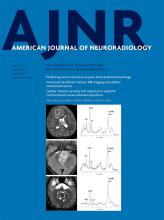Index by author
Yamamoto, M.
- EDITOR'S CHOICENeurointerventionYou have accessUsefulness of Silent MR Angiography for Intracranial Aneurysms Treated with a Flow-Diverter DeviceH. Oishi, T. Fujii, M. Suzuki, N. Takano, K. Teranishi, K. Yatomi, T. Kitamura, M. Yamamoto, S. Aoki and H. AraiAmerican Journal of Neuroradiology May 2019, 40 (5) 808-814; DOI: https://doi.org/10.3174/ajnr.A6047
Silent MRA is a procedure using an ultrashort TE and arterial spin-labeling techniques, which efficiently visualizes the status after the treatment of intracranial aneurysms. In Silent MRA, the 3D image is reconstructed by subtracting the control image from the image obtained by the labeling pulse. Seventy-eight large, unruptured internal carotid aneurysms in 78 patients were the subjects of this study. After 6 months of treatment, they underwent follow-up digital subtraction angiography, Silent MRA, and TOF-MRA, performed simultaneously. The authors found Silent MRA is superior for visualizing blood flow images inside flow-diverter devices compared with TOF-MRA. Furthermore, Silent MRA enables the assessment of aneurysmal embolization status. Silent MRA is useful for assessing the status of large and giant unruptured internal carotid aneurysms after flow-diverter placement.
Yamashita, K.
- FELLOWS' JOURNAL CLUBPediatricsOpen AccessIntravoxel Incoherent Motion MR Imaging of Pediatric Intracranial Tumors: Correlation with Histology and Diagnostic UtilityK. Kikuchi, A. Hiwatashi, O. Togao, K. Yamashita, R. Kamei, D. Momosaka, N. Hata, K. Iihara, S.O. Suzuki, T. Iwaki and H. HondaAmerican Journal of Neuroradiology May 2019, 40 (5) 878-884; DOI: https://doi.org/10.3174/ajnr.A6052
Between April 2013 and September 2015, seventeen children with intracranial tumors were included in this retrospective study. Intravoxel incoherent motion parameters were fitted using 13 b-values for a biexponential model. The perfusion-free diffusion coefficient, pseudodiffusion coefficient, and perfusion fraction were measured in high- and low-grade tumors. The authors found significant correlations between the histology and IVIM parameters of different pediatric intracranial tumors. These results suggest that IVIM imaging reflects cell density and vascularity across different types of pediatric brain tumors. They also demonstrated that both the diffusion and perfusion parameters measured on IVIM imaging are useful for grading intracranial neuroectodermal tumors in pediatric patients.
Yatomi, K.
- EDITOR'S CHOICENeurointerventionYou have accessUsefulness of Silent MR Angiography for Intracranial Aneurysms Treated with a Flow-Diverter DeviceH. Oishi, T. Fujii, M. Suzuki, N. Takano, K. Teranishi, K. Yatomi, T. Kitamura, M. Yamamoto, S. Aoki and H. AraiAmerican Journal of Neuroradiology May 2019, 40 (5) 808-814; DOI: https://doi.org/10.3174/ajnr.A6047
Silent MRA is a procedure using an ultrashort TE and arterial spin-labeling techniques, which efficiently visualizes the status after the treatment of intracranial aneurysms. In Silent MRA, the 3D image is reconstructed by subtracting the control image from the image obtained by the labeling pulse. Seventy-eight large, unruptured internal carotid aneurysms in 78 patients were the subjects of this study. After 6 months of treatment, they underwent follow-up digital subtraction angiography, Silent MRA, and TOF-MRA, performed simultaneously. The authors found Silent MRA is superior for visualizing blood flow images inside flow-diverter devices compared with TOF-MRA. Furthermore, Silent MRA enables the assessment of aneurysmal embolization status. Silent MRA is useful for assessing the status of large and giant unruptured internal carotid aneurysms after flow-diverter placement.
Yonemoto, N.
- NeurointerventionOpen AccessDifferences in Cerebral Aneurysm Rupture Rate According to Arterial Anatomies Depend on the Hemodynamic EnvironmentS. Fukuda, Y. Shimogonya and N. Yonemoto on behalf of the CFD ABO Study GroupAmerican Journal of Neuroradiology May 2019, 40 (5) 834-839; DOI: https://doi.org/10.3174/ajnr.A6030








